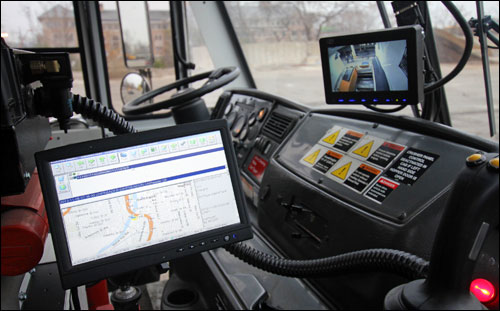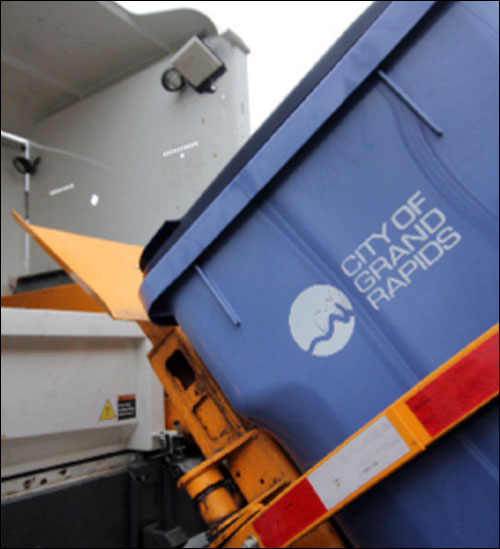Jun 17, 2013Like people in cities and towns worldwide, the citizens of Grand Rapids, Mich., generate a lot of trash. The garbage is hauled to a county incinerator, and then some of it is transferred to a landfill. "The county incinerator has a maximum amount it can burn per day," says James Hurt, public services director for the city. "Anything beyond that capacity is transported to a landfill." The incinerator has controls to reduce emissions, he adds, but trash burned in the incinerator contributes to air pollution.
In 2010, the Midwestern city developed an ambitious three-phase plan that uses RFID to reduce the amount of trash sent to the county incinerator and landfill, while lowering costs and improving operations. The first phase, implemented in 2010, encourages residents to recycle by rewarding them with points redeemable for discounts and free merchandise at local businesses. The second phase, deployed in 2012, manages garbage collection and charges households only for what they throw out, decreasing the amount some residents pay. The final phase, currently in development, will be a system to collect food scraps and yard waste for composting, further allowing residents to reduce their garbage outflow.
With the first two phases rolled out successfully, the city is already seeing solid environmental and economic benefits. "The city has a sustainability plan," Hurt says. After some initial skepticism, residents are embracing both programs. That's due, in part, to an approach that benefits participants, he says. "We also have a community that truly cares for the environment," he adds. "I would liken it to a core community value."
Beyond the environmental benefits, Grand Rapids has lowered its incinerator fees and improved operational efficiencies. Hurt projects annual savings going forward of approximately $1.2 million a year.
Phase 1: Rewards for Recycling
Since 2010, Grand Rapids has been using RFID-enabled carts and trucks to manage recycling. Each SmartCart, made with recycled materials by the local firm Cascade Engineering, is fitted with an ultrahigh-frequency Gen 2 EPC Snap-In tag from Xtreme RFID, a Cascade subsidiary. The tag's ID number is linked to a customer's account. The trucks are equipped with mechanical platforms that lift and empty the carts, so drivers don't have to hoist the recyclables manually. The trucks are also equipped with an RFID reader and antenna from AMCS Group, which captures the tag's ID number as the cart is tipped. That information is transmitted to a GPS-enabled computer mounted on the truck's dashboard, and then to the city's back-office application via mobile communications. Capturit, another Cascade subsidiary, provides the onboard computers and software for the project.
Grand Rapids uses the information to identify which areas have high and low recycling rates, to better understand recycling practices and trends throughout the city. The city also rewards residents who recycle through an innovative program called myGRcitypoints. "You register your cart, and each time you put it out to the curb it assigns you points," Hurt says. The points are based on the total weight of recycling collected on a day's route—the heavier the truck, the more points everyone gets. Thus, it's to residents' advantage not only to recycle their own trash, but to encourage their neighbors to recycle as well.
The points can be exchanged for special offers at local businesses, such as a free sticky bun with brunch at an eatery or the opportunity to name a new beer at a brewery. People also can use the points to improve their neighborhoods. Grand Rapids recently ran a campaign in which it invited residents to donate their points to their favorite park. The winning park received nearly 1 million donated points—and $50,000 from the city for improvements. Some 47,000 households are currently using SmartCarts for recycling.
Phase 2: Upgrading Trash Collection
For about four decades, most Grand Rapids residents prepaid for trash pickup by purchasing 32-gallon garbage bags, which the city sold at a variety of stores and other locations, for $2.50 each. Charging by the bag created a financial incentive for residents to minimize trash, but administering the program and distributing bags to stores throughout the city was labor-intensive. "We were stocking and delivering one million bags a year throughout the community," Hurt says. The bags also added more plastic to the trash stream, and burning plastic in incinerators releases heavy metals into the air.

In 2012, Grand Rapids spent six months creating a pay-as-you-throw trash-collection system. The city upgraded its fleet of waste-collection trucks and purchased some new ones. "There are two types of trucks—semi-automated, where the driver gets out, wheels the cart to the tipper, operates a lever and dumps the trash, and fully automated, which has an arm that grabs the cart and dumps the container so the driver doesn't have to get out," says Mike Lewis, business unit leader at Xtreme RFID. All the trucks are equipped with RFID readers and antennas, and onboard computers. The city also invested in SmartCarts for trash collection, and Capturit developed software and databases to manage the new system.
Then, Grand Rapids began to roll out the pay-as-you-throw program to the city's approximately 65,000 households. It's offered as an alternative to using the city's plastic bags and replaces a subscription service, which some 10,000 households had used. Residents have accounts that they refill with funds by phone or over the Internet. Trucks collect trash weekly, and residents pay only for what they actually throw out. If a resident puts a garbage cart at the curb, the truck will empty it at a cost to the resident of $2, $4 or $6, depending on its size. If the resident doesn't put out a cart, there is no charge.
The new system encourages residents to lower their own costs by recycling more and throwing away less, Hurt says. "With a subscription, you're paying the same price as everyone else," he says. "This way, you're paying for the service when you use it. If you go away for a week or two, you don't pay for service. If your cart is half full and you don't put it out that week, you don't pay for service."
The trucks' onboard computers act as enforcers by telling drivers when not to pick up trash. "The city has the ability to 'stop lift' those customers who haven't paid for trash pickup," says Mark Harvey, national sales director at Capturit. If a driver inadvertently attempts to empty a cart on the stop list, the reader will capture the tag's ID number and the onboard software will prevent the truck from completing the lift. Residents can sign up to receive e-mail or text low-balance reminders.
Grand Rapids anticipated residents might be skeptical of the pay-as-you-throw system, and, some folks did stockpile bags or opt for a private service. But the city had a plan to encourage adoption: make pay-as-you-throw more appealing than buying bags. It set the price for a 32-gallon cart at $2 per tip, whereas a pack of 10 32-gallon bags for city waste disposal cost $25. It also made the bags less convenient to obtain. Instead of selling them at locations throughout the city, they were available only at the Public Services office.
At the same time, the city launched a massive promotional campaign. "We did a fair number of community meetings, mailings, media releases and billboards," Hurt says. "We did radio shows and demonstrations with carts."
Today, roughly 36,000 customers are using the pay-as-you-throw service. Since a portion of the city's households are apartments in buildings that handle trash collection for their residents, it seems clear that more than half the households that can use the program are doing so. And that number is climbing. "We have signups every day," Hurt says.
Grand Rapids' recycling and trash programs are already having a positive impact on the environment. In 2012, recycling was up roughly 4,000 tons a year, and garbage was down a corresponding 4,000 tons. As a result, the city is diverting less waste to the landfill.
With more residents using carts instead of the city's garbage bags, air quality benefits. "Part of our overall goal is to reduce the amount of plastics being burned," Hurt says. "We're not burning a million bags a year anymore."
The pay-as-you-throw program also is saving the city money. Less garbage means lower incinerator fees. Since the city began using trucks with automated lifts and onboard computers that tell drivers which addresses to skip, trash collection has become more efficient, saving on fuel and equipment, as well as driver time and risk of injury. In addition, eliminating the subscription service saves the city from sending out more than 40,000 invoices each year. Hurt anticipates the program, with total costs of $2.4 million, will have paid for itself within five years.
Phase 3: Composting
The program's success is due, in large part, to the participation of people from many parts of the city's government, Lewis says, including operations, customer service and finance, as well as input from the drivers. "The mayor and the city manager were involved," he adds. "A lot of departments within the city had input into scoping out the service and selecting it."
A team of representatives from all these areas continues to talk once a week, to discuss any problems and plan for the next phase of garbage reduction: composting food scraps and yard waste. "We're looking to have something in place for fall 2013," Hurt says.
Ultimately, Hurt wants to see Grand Rapids produce as little trash as possible. "Zero waste stream—putting nothing in the trash—that's a goal," he says, though he acknowledges it may be a tough one to reach. But he believes Grand Rapids and other cities can vastly reduce the amount of trash they produce. "I'd love to see only 10 percent of what we throw away go in the incinerator," he says.

